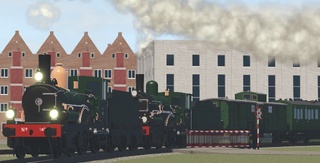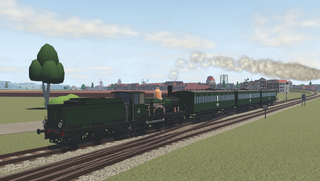 | |
| NS 1300 | |
|---|---|
| by Supersnel11 | |
| Price | Free |
| Statistics | |
| Type | Passenger |
| Top Speed | 90 km/h |
| Weight | 82 tons |
| Capacity | 230 tons |
| Passenger Capacity | 1 first class 1 second class |
| Length | 16,4 meters |
The NS 1300 is a series of Dutch 2'B (4-4-0) passenger locomotives that were renumbered when the rest of the NS 1700 class got superheaters. It is currently the steam counterpart of the starter locomotive NS 2000.
Variants
The locomotive is only available in standard Nederlandsche Spoorwegen green.
Historic details
The SS 801-935
In order to pull the increasingly heavy passenger trains, the Staatsspoorwegen (SS) designed a locomotive based on their 301-475 series that was put into service in 1899. Much like the 'Grote Groene', these machines were a large success. They pulled the most important trains until 1910, when the SS 700 (later NS 3700) series entered service.
The first 125 were built by Beyer, Peacock and Company, and Werkspoor delivered two more series of five. The engines were delivered without superheaters. A test was done with SS 856 around 1912, but results were unsuccessful so the locomotive retained a regular firebox again. A second trial with 865 and 889 was successful, which started a 30 year period in which the majority of the SS 800s got superheaters.
NS 1701-1835
Once the SS and HSM merged into NS, the engines were renumbered to NS 1701-1825. NS continued to fit 92 locomotives with superheaters but was unable to finish the whole series due to financial troubles. The remaining 29 of the class, those without superheaters, were slowly phased out of mainline work in the 1930s. Around the same time the general public started calling them "Hartjes" (Little hearts) because of the heart-shaped windows on the cab, which the others had lost.

These superheater-less 1700s served in 34 different depots throughout the 1920s and '30s. Sometimes for a little while, sometimes for a few years in a row. A couple of them were stored away after the fusion of the HSM & SS and often only put back in service once they got a new boiler with a superheater. A crisis in 1929 resulted in some being stored again. The most important depots which still had some superheater-less 1700s were Boxtel, Gennep, Maastricht, Tilburg an Venlo. In 1939, the depots Nijmegen, Zutphen but mostly Feijenoord had a large amount of these locomotives in service. At the latter they were mainly used for light goods trains.
They started putting the first non-fitted engines out of service in 1938. That year the 1728/40/51/81/96 and 1821 were withdrawn from service. NS 1806 and 1810 went the following year.
The NS 1300
A decision was made to distinguish the last 23 1700s without a superheater (1708/12/19/33/36/42/45/58/59/64/83/90/92/98/99, 1809/13/14/20/23/25/32 and 1833) from the 1700s with a superheater in 1941. By this time, the series SS 301-475/NS 1300) had gone out of service, freeing up the numbers 1300/1400, so those were used. Although the series number changed, the order was preserved. This created large gaps in the numbering.
NS 1345 and NS 1392 received their superheaters in 1942 and 1943, much later than the others, which was a trick of NS to save personnel in the Tilburg workshop from having to go work in Germany. Once they got superheaters installed, they also retained their old numbers.
In the last winter of WWII, 13 1300s (1308/12/19/33/36/42/59/83/90/93, 1409/14 and 1423) were sent off to Germany, of which 1383, 1390 and 1409 did not return. The three of them were administratively written off in 1948. In 1945, 1354, 1413, 1420 and 1425 were properly written off. The others followed in 1949, with the exception of 1399, which stayed in service until 1949.
Technical details
The 1300s were equipped with a Westinghouse brake and a connection for steam heating, though only on the tender. The steam dome was secured with Adams security.
The first 35 had the springs on the rear driven axle on top of the frame, where the rest had their number plate mounted. The numbers were painted on the side of the cab, roughly at the height of the top of the firebox. These 35 machines were also recognisable by their cab windows, which were circular instead of the heart-shape the rest was delivered with. With the goal of increasing the space in the cab, the springs on the rear driven axle were placed underneath the frame and in later years, the first 35 were modified to be the same.
The first 65 locomotives originally had a different type of bogie that caused the locomotives to not run smoothly.
The SS 866-935 had boilers with Serve boiler tubes. These had an external diameter of 70 mm and eight longitudinal ribs. These were expected to result in better steam production, but in practice, this advantage could not outweigh the drawback that only 88 Serve tubes could fit inside a boiler, as opposed to 220 regular tubes. The heating surface of these Serve tubes was 111 m² against 93 m² of the regular tubes. The heat-taking area was increased with 17%, though the heat-giving area was decreased by about 35%. However, it remains difficult to compare the two because gasses and liquids react differently to contacts with the different metals. A clear downside is that the Serve tubes got clogged way more often than the regular tubes, especially when the boiler was being worked hard and as such, leaks were not uncommon. All locomotives with these tubes got them replaced with regular ones when the tube plates had to be replaced.
From 1918 onwards, all 1700s, whether they had a superheater or not, received a Knorr pre-heating installation with a heating surface of 9,2 m² and a pumping capability of 120 litres a minute.
In 1921, the place of the driver position was moved from the left to the right on all locomotives, as per the NS standard.
The 1700s that had not yet received a superheater in 1924 received an air-powered bell to use on the branchlines and lines on the German border in that year. Additionally, all 1700s also got partitions to protect the personnel. The entire series was also equipped with Henry airbrakes in 1933.
Trivia
- The NS 1300 is the starter locomotive, free for all players.
- The previous starter locomotive was the NS 2100, a now high level locomotive.
- Because the class consisted entirely of NS 1700s that did not get rebuilt, the available numbers are not in order.
- The numbers given to NS 1300s are not available on NS 1700s (example: because you can get 1308, you can't get 1708)
- The NS 1300 was added in version 0.5.17.
- In version 0.7.6, the NS 1300 received a temporary snowplough livery for the winter season of 2023.
Gallery
-
An NS 1300 doubleheading with an NS 1700.
-
NS 1399 with a short passenger train between Beurs and Hoogburg.


